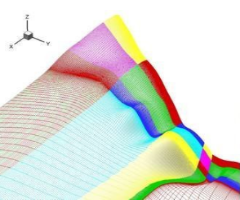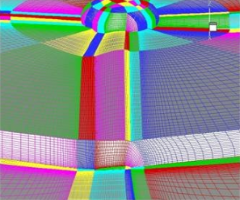Mesh deformation
Staff:
Unsteady flow simulation often involves moving boundaries, either rigid or deforming. Once a mesh boundary has moved or deformed, the volume mesh must also deform. This can be an expensive problem, as the mesh must move/deform every time step, and so the development of an efficient mesh motion scheme is essential. Professor Allen has developed many mesh motion schemes, and has recently developed, with Dr Rendall, a very effective scheme, which is applicable to any mesh type (structured or unstructured), is linearly scalable in parallel, and preserves mesh quality by maintaining orthogonality at the moving surfaces. This is based on a universal volume interpolation function, based on radial basis functions (RBFs). These methods have also been extended to allow surface shape control for aerodynamic shape optimisation (see aerodynamic optimisation).
The simplest form of the RBF scheme is expensive, and so much effort has been expended on efficient implementation, particularly reducing the problem size. Below is an example application, deformation of an eight million cell multiblock mesh for the MDO wing. The first image below (left) shows the surface mesh, deformed by an exaggarated 18th structural mode shape deflection (wake and tip slits are also shown). The other images below (centre, right) show selected grid planes, to demonstrate mesh quality.



Another example application is shown, the cyclic pitch of rotor blades in forward flight. The image below (left) shows selected mesh planes for an undeformed five million cell four-bladed rotor case. The other images below (centre, right) show the same planes for an exaggerated pitch motion (up to 50 degrees rotation), showing the smooth variation obtained and preserved orthogonality at the surfaces.


